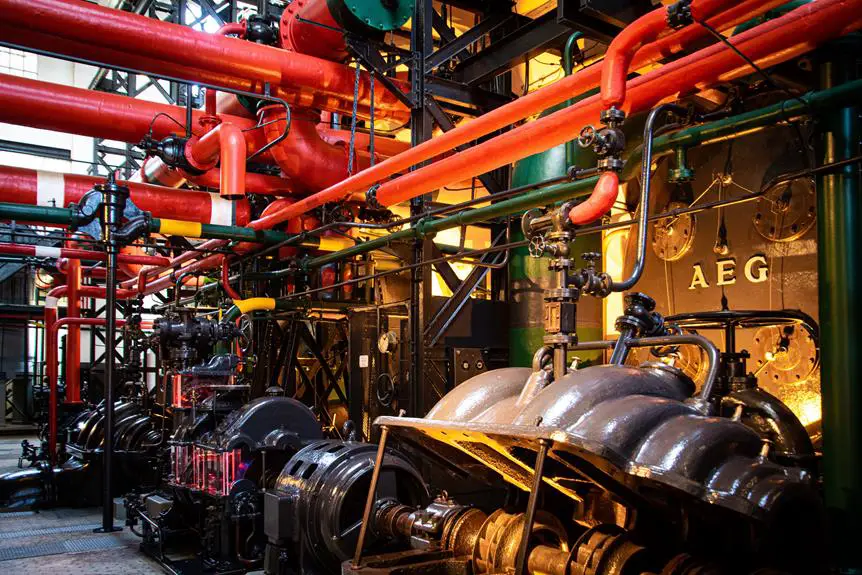Wondering if elastic heavy-duty fabric is worth the investment? Look no further.
This concise guide will provide an objective and detailed analysis to help you determine if this fabric is the right choice for your needs.
We'll explore the advantages, applications, durability, and compare it to traditional options.
By the end, you'll have a comprehensive understanding of whether elastic heavy-duty fabric is a wise investment for your projects.
Key Takeaways
- Elastic heavy-duty fabric offers superior flexibility and exceptional strength, making it a worthwhile investment.
- It is highly durable and resilient to abrasion, making it ideal for outdoor gear, DIY projects, medical and sports equipment, and industrial applications.
- The fabric is designed to withstand wear and tear, ensuring longevity and reliability in harsh conditions.
- Its versatility and stretchiness make it suitable for a wide range of applications, including athletic apparel, furniture upholstery, medical garments, and outdoor gear.
Elastic Heavy-Duty Fabric: What Sets It Apart
When choosing heavy-duty fabric, you'll notice that elastic heavy-duty fabric stands out due to its exceptional flexibility and durability. This type of fabric possesses stretchy resilience, allowing it to be stretched and pulled without losing its shape or strength. This feature makes it highly desirable for various industrial applications where the fabric needs to withstand constant movement and stress.
Additionally, elastic heavy-duty fabric offers superior durability, making it suitable for demanding environments. Its ability to maintain its shape and structure over time ensures that it can withstand the rigors of industrial use without compromising its performance.
In industrial settings, elastic heavy-duty fabric finds wide applications, from manufacturing and construction to transportation and sports equipment. Its stretchy resilience enables it to endure the continuous wear and tear that industrial settings often subject materials to. Moreover, the fabric's durability ensures that it can withstand harsh conditions, making it a reliable choice for a wide range of industrial purposes.
Whether it's for creating protective gear, durable packaging, or heavy-duty clothing, the exceptional flexibility and resilience of elastic heavy-duty fabric set it apart as a top choice for industrial applications.
Advantages of Elastic Heavy-Duty Fabric
You'll appreciate the durability of elastic heavy-duty fabric, as it can withstand tough conditions and heavy use without losing its shape or strength.
Its versatile and stretchy nature allows for a wide range of applications, making it suitable for various projects and uses.
These advantages make elastic heavy-duty fabric a practical and reliable choice for those seeking long-lasting and adaptable materials.
Durability in Tough Conditions
In tough conditions, elastic heavy-duty fabric withstands wear and tear, making it a reliable investment for demanding tasks. Its longevity and reliability in harsh conditions set it apart from traditional fabrics. This fabric is designed to endure rigorous use, making it ideal for various applications. Here's a breakdown of its advantages in tough conditions:
| Advantages of Elastic Heavy-Duty Fabric |
|---|
| 1. Superior Flexibility |
| 2. Exceptional Strength |
| 3. Enhanced Durability |
| 4. Resilience to Abrasion |
| 5. Weather Resistance |
These features collectively make elastic heavy-duty fabric an excellent choice for withstanding tough conditions. Whether it's for heavy-duty workwear, outdoor equipment, or industrial applications, this fabric's durability ensures that it can handle the challenges of demanding environments.
Versatile and Stretchy Material
With elastic heavy-duty fabric, you can rely on its versatility and stretchiness for a wide range of applications, thanks to its exceptional flexibility and resilience. The material's stretchy comfort and durable flexibility offer numerous benefits, making it a valuable investment.
Here's why:
- Athletic Apparel: The fabric's stretchiness allows for a full range of motion, making it ideal for sportswear and activewear.
- Furniture Upholstery: Its ability to stretch and conform to furniture shapes ensures a snug and tailored fit for upholstery, enhancing both comfort and durability.
- Medical Garments: The fabric's stretchy nature provides comfort for patients while maintaining durability for long-term use in medical garments.
- Outdoor Gear: From tents to backpacks, the material's versatility and stretchiness make it suitable for various outdoor gear, offering resilience and adaptability to different conditions.
Applications of Elastic Heavy-Duty Fabric
Elastic heavy-duty fabric offers versatile usage options, making it suitable for a wide range of applications such as outdoor gear, athletic wear, and medical equipment.
Its durability in tough conditions ensures that it can withstand rugged environments and heavy use, providing long-lasting performance.
Understanding the impact of elastic heavy-duty fabric on performance can help you make informed decisions about its application in various products and industries.
Versatile Usage Options
You can find a multitude of applications for elastic heavy-duty fabric in various industries and everyday use. Its customization options and multipurpose nature make it a versatile material for a wide range of applications.
Here are some ways you can utilize elastic heavy-duty fabric:
- Outdoor Activities: Whether it's for creating durable and flexible outdoor gear like backpacks, tents, or hammocks, elastic heavy-duty fabric excels in providing strength and flexibility for various outdoor pursuits.
- DIY Projects: From creating custom-fit furniture covers to designing resilient and stretchable clothing, this fabric is perfect for DIY enthusiasts looking to add durability and flexibility to their creations.
- Medical and Sports Equipment: The fabric's ability to stretch and withstand rigorous use makes it ideal for medical braces, athletic gear, and support bands.
- Industrial Applications: This fabric is also used in industrial settings for conveyor belts, safety harnesses, and flexible containers due to its heavy-duty nature and elasticity.
Durability in Tough Conditions
When considering heavy-duty fabric, one may appreciate its ability to withstand tough conditions, making it an essential investment for various applications.
The durability of elastic heavy-duty fabric is unmatched, providing strength and flexibility in challenging environments. Whether used in outdoor gear, industrial settings, or automotive applications, this fabric can endure harsh weather conditions, heavy loads, and constant movement without compromising its integrity.
Its resistance to abrasion, tearing, and punctures ensures a long lifespan, reducing the need for frequent replacements. The combination of strength and flexibility allows the fabric to maintain its structural integrity while accommodating dynamic movements and stress.
This makes it an ideal choice for applications that require reliable performance under demanding conditions, solidifying its reputation as a worthwhile investment for durability in tough environments.
Impact on Performance
Incorporating elastic heavy-duty fabric into your applications can significantly enhance performance and durability, meeting the demands of challenging environments with ease. The performance benefits and material properties of elastic heavy-duty fabric make it an ideal choice for various applications.
Here's how it can impact your performance:
- Flexibility: The elasticity of the fabric allows for greater flexibility and freedom of movement, crucial for applications that require agility and dexterity.
- Strength: The fabric's heavy-duty nature provides exceptional strength, enhancing the performance and longevity of the end product.
- Resilience: Elastic heavy-duty fabric exhibits remarkable resilience, maintaining its form and functionality even in the face of rigorous use and demanding conditions.
- Adaptability: Its ability to conform to different shapes and contours ensures seamless integration into a wide range of applications, optimizing overall performance.
Durability and Longevity of Elastic Heavy-Duty Fabric
Considering the demands of heavy use and frequent stretching, investing in elastic heavy-duty fabric proves to be a smart choice for long-term durability and longevity. Durability testing and fabric strength are crucial factors in determining the potential lifespan of elastic heavy-duty fabric. When subjected to rigorous durability testing, this fabric consistently demonstrates its ability to withstand extensive wear and tear, making it an ideal choice for high-traffic areas or frequently used items. The fabric's strength is a result of its composition, often featuring a blend of resilient materials such as polyester, nylon, and spandex, which contribute to its exceptional tensile strength and resistance to stretching and deformation over time.
| Durability Testing | Fabric Strength | Longevity |
|---|---|---|
| Rigorous and thorough | High tensile | Extended |
| testing ensures that | strength and | lifespan due to |
| the fabric can | resistance to | its resistance |
| withstand heavy use | stretching and | to wear and tear |
Investing in elastic heavy-duty fabric for upholstery, apparel, or any application that requires resilience and longevity is a prudent decision, given its proven durability and long-term performance.
Elastic Heavy-Duty Fabric Vs. Traditional Options
If you're comparing elastic heavy-duty fabric to traditional options, you'll find notable differences in flexibility and resilience.
- Flexibility: Elastic heavy-duty fabric offers superior flexibility compared to traditional fabric alternatives. It conforms to various shapes and movements, making it ideal for applications that require stretch and recovery.
- Resilience: When it comes to resilience, elastic heavy-duty fabric outperforms traditional options. It can withstand repeated stretching and bouncing back to its original shape, making it a durable choice for demanding environments.
- Cost Comparison: While elastic heavy-duty fabric may have a higher upfront cost than traditional options, its durability and longevity often result in cost savings over time. The need for frequent replacements due to wear and tear is significantly reduced with elastic heavy-duty fabric, making it a cost-effective choice in the long run.
- Adaptability: Elastic heavy-duty fabric is highly adaptable, making it suitable for a wide range of applications including sportswear, medical garments, and industrial purposes. Traditional options may not offer the same level of versatility and performance.
When considering elastic heavy-duty fabric versus traditional options, it's essential to weigh the initial cost against the long-term benefits and performance.
Factors to Consider Before Choosing Elastic Heavy-Duty Fabric
Before choosing elastic heavy-duty fabric, consider the specific requirements of your intended application. Factors such as material properties, cost, and maintenance considerations should guide your decision-making process. To help you make an informed choice, here are some key factors to consider:
| Factors to Consider | Description |
|---|---|
| Material Properties | Assess the fabric's strength, durability, elasticity, and resistance to abrasion, chemicals, and environmental factors. |
| Application Requirements | Determine the specific needs of your project, including the level of stretch, recovery, and overall performance demanded by the application. |
| Cost | Evaluate the initial purchase cost, as well as the long-term value in terms of lifespan, performance, and potential savings in maintenance and replacement. |
| Maintenance Considerations | Consider the fabric's care requirements, such as cleaning methods, resistance to staining, and the need for special treatments or protective coatings. |
| Environmental Impact | Assess the fabric's sustainability, recyclability, and overall environmental footprint. |
Tips for Working With Elastic Heavy-Duty Fabric
When working with elastic heavy-duty fabric, it's essential to understand the specific techniques for handling and manipulating its stretch and recovery properties effectively.
Here are some tips for working with this type of fabric:
- Sewing Techniques: Use a stretch needle and a longer stitch length to prevent skipped stitches and fabric puckering. When sewing seams, consider using a stretch stitch or a narrow zigzag stitch to maintain the fabric's elasticity.
- Best Practices for Cutting: To prevent distortion, lay the fabric flat and use pattern weights instead of pins. Consider cutting the fabric with a rotary cutter or sharp fabric scissors to ensure clean edges.
- Handling Seam Allowances: Trim down seam allowances to reduce bulk and use a serger or overlock machine to finish the edges, providing a professional and durable finish.
- Testing and Adjusting Tension: Before starting a project, test the sewing machine's tension and adjust it as needed to accommodate the fabric's stretch and thickness.
Making the Decision: Is Elastic Heavy-Duty Fabric Right for You?
Considering the durability and stretch properties of elastic heavy-duty fabric, you may find it to be a valuable investment for projects requiring resilience and flexibility. When weighing options for material selection, it's essential to conduct a cost-benefit analysis to determine if elastic heavy-duty fabric aligns with your project needs. To aid in your decision-making process, a durability comparison between elastic heavy-duty fabric and other materials can provide insight into the long-term performance and maintenance costs.
| Criteria | Elastic Heavy-Duty Fabric | Alternative Material A | Alternative Material B |
|---|---|---|---|
| Durability | High | Medium | Low |
| Stretch Properties | Excellent | Limited | None |
| Cost | Moderate | Low | High |
Elastic heavy-duty fabric's high durability and excellent stretch properties make it suitable for various applications, but it's crucial to consider the cost and compare it with alternative materials. Conducting a thorough cost-benefit analysis will help in making an informed decision about whether elastic heavy-duty fabric is the right choice for your project.
Frequently Asked Questions
How Does Elastic Heavy-Duty Fabric Compare to Other Types of Heavy-Duty Fabrics, Such as Canvas or Denim?
When comparing heavy-duty fabrics like elastic, canvas, and denim, consider their durability, versatility, and application. Elastic fabric offers superior stretch and recovery, making it ideal for applications requiring flexibility and resilience.
Can Elastic Heavy-Duty Fabric Be Used for Outdoor Applications, Such as Patio Furniture or Awnings?
Yes, elastic heavy-duty fabric is suitable for outdoor applications like patio furniture and awnings. It offers excellent outdoor durability, and application techniques ensure a secure fit. It's a versatile choice for various outdoor projects.
What Are the Care and Maintenance Requirements for Elastic Heavy-Duty Fabric?
For proper care and maintenance of elastic heavy-duty fabric, regularly wash with mild detergent and cool water. Avoid harsh chemicals and excessive stretching. This ensures durability and longevity, preserving its stretching techniques for various applications.
Are There Any Specific Tools or Techniques That Are Recommended for Working With Elastic Heavy-Duty Fabric?
When working with elastic heavy-duty fabric, you'll need specialized tools like a walking foot or ballpoint needle. Use stretch stitches and proper tension settings for durability. Mastering these techniques ensures successful sewing projects.
What Are Some Real-Life Examples of Where Elastic Heavy-Duty Fabric Has Been Successfully Used and Proven to Be Worth the Investment?
Elastic heavy-duty fabric is a smart investment due to its durability and longevity. It offers cost-effective value and has been successfully used in outdoor gear, medical textiles, and industrial applications, proving its worth.
- Can You Get Organza Wet? - April 23, 2024
- Why Is Organza so Popular? - April 23, 2024
- What Do You Wear With Organza? - April 23, 2024





